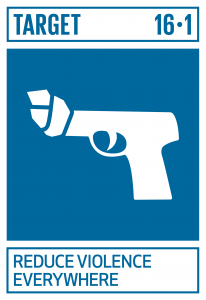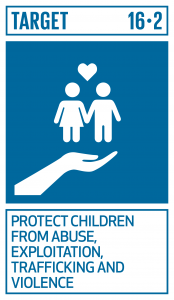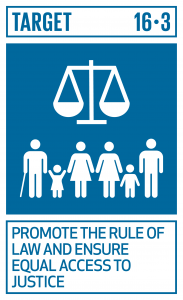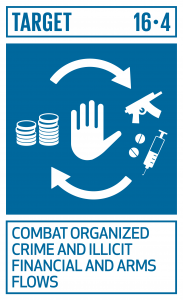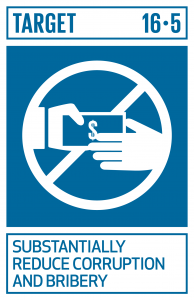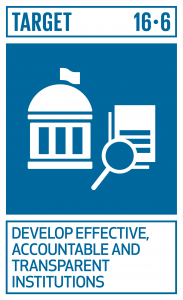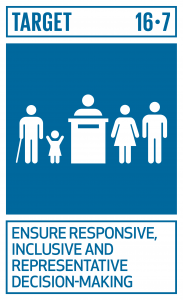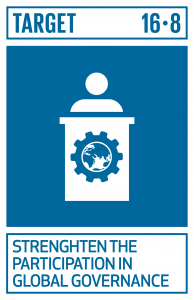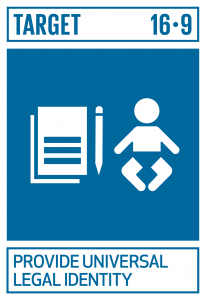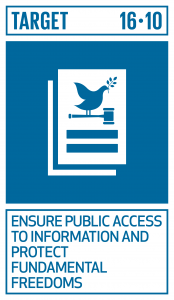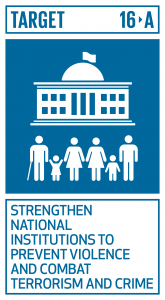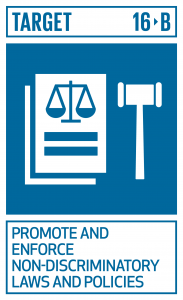SDG 16 seeks to “promote peaceful and inclusive societies for sustainable development, provide access to justice for all and build effective, accountable and inclusive institutions at all levels.”1 Its monitoring framework includes twelve targets, each of which have between one and four indicators.2
As a part of promoting peace, justice and strong institutions, the targets for SDG 16 are aimed at a wide array of topics. These topics include reducing violence (16.1, 16.2, and 16.A), reducing corruption and organized crime (16.4 & 16.5), developing strong and representative institutions (16.6, 16.7, and 16.A), and promoting individual rights (16.3, 16.9, and 16.B). The targets also promote institutional transparency (16.6 & 16.10) and accountability (16.6, 16.8, and 16.10).3
Indicator Measurement
16.1.1 Number of victims of intentional homicide per 100,000
16.1.2 Conflict-related deaths per 100,000 population, by sex, age and cause
16.1.3 Proportion of population subjected to physical, psychological, or sexual violence in the previous 12 months
16.1.4 Proportion of population that feel safe walking alone around the area they live
16.2.1 Proportion of children aged 1-17 years who experienced any physical punishment and/or psychological aggression by caregivers in the past month
16.2.2 Number of victims of human trafficking per 100,000 population, by sex, age and form of exploitation
16.2.3 Proportion of young women and men aged 18-29 years who experienced sexual violence by age 18
16.3.1 Proportion of victims of violence in the previous 12 months who reported their victimization to competent authorities or other officially recognized conflict resolution mechanisms
16.3.2 Unsentenced detainees as a proportion of overall prison population
16.4.1 Total value of inward and outward illicit financial flows (in current United States dollars)
16.4.2 Proportion of seized, found or surrendered arms whose illicit origin or context has been traced or established by a competent authority in line with international instruments
16.5.1 Proportion of persons who had at least one contact with a public official and who paid a bribe to a public official, or were asked for a bribe by those public officials, during the previous 12 months
16.5.2 Proportion of businesses that had at least one contact with a public official and that paid a bribe to a public official, or were asked for a bribe by those public officials during the previous 12 months
16.6.1 Primary government expenditures as a proportion of original approved budget, by sector (or by budget codes or similar)
16.6.2 Proportion of the population satisfied with their last experience of public services
16.7.1 Proportions of positions (by sex, age, persons with disabilities and population groups) in public institutions (national and local legislatures, public service, and judiciary) compared to national distributions
16.7.2 Proportion of population who believe decision-making is inclusive and responsive, by sex, age, disability and population group
16.8.1 Proportion of members and voting rights of developing countries in international organizations
16.9.1 Proportion of children under 5 years of age whose births have been registered with a civil authority, by age
16.10.1 Number of verified cases of killing, kidnapping, enforced disappearance, arbitrary detention and torture of journalists, associated media personnel, trade unionists and human rights advocated in the previous 12 months
16.10.2 Number of countries that adopt and implement constitutional, statutory and/or policy guarantees for public access to information
16.A.1 Existence of independent national human rights institutions in compliance with the Paris Principles
16.B.1 Proportion of population reporting having personally felt discriminated against or harassed in the previous 12 months on the basis of a ground of discrimination prohibited under international human rights law
Context
SDG 16 does not directly descend from any particular Millennium Development Goal (MDG). Instead, it builds on underlying concepts from several MDGs and applies them in a different context. For example, MDG 2 (universal primary education)4 is closely tied to SDG 16.10 (access to information). Education is an important step in providing access to information because the public must be able to understand the information they receive. MDG 4 (reducing child mortality)5 and MDG 6 (combating AIDS, malaria, and other diseases)6 were also closely related to SDG 16.1 (significantly reduce all forms of violence) and SDG 16.2 (end violence against and trafficking of children). SDG 16.1 & 16.2 build upon and expand the concepts of health and safety that were present in MDGs 4 & 6.
The SDGs promotes a more holistic view of health, safety, and rights than the MDGs. Not only do the SDGs continue to promote bodily health (SDG 3), SDG 16 seeks to fight violence (SDGs 16.1 & 16.2) which helps prevent other forms of danger or death. SDG 16.2 also places a special emphasis on children – a group that is particularly at risk.
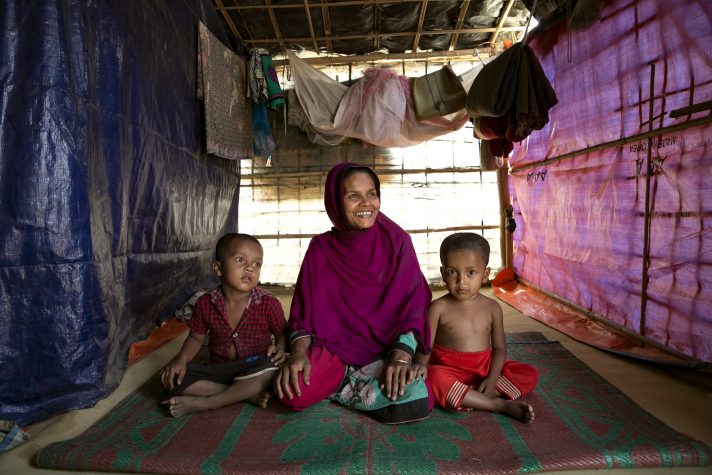
Children, especially experiencing like the Rohingya in Myanmar, are particularly at risk when institutional frameworks fail. Photo by UN Women/Allison Joyce, Flickr. Licensed under CC BY-NC-ND 2.0.
SDG 16 is also interlinked with many other SDGs. For example, the underlying concepts of health and safety present in targets 16.1 (significantly reduce all forms of violence) and 16.2 (end violence against and trafficking of children) are also present in SDG 1 (No poverty), SDG 2 (Zero hunger),7 and SDG 3 (Good health and well-being).8 Furthermore, targets 16.B and 16.7 promote notions of equality and inclusiveness that are present in SDG 5 (Gender equality)9 and SDG 10 (reduced inequalities).10
Regionalisation and Localisation
Little progress has been made on the implementation of SDG 16 in the Lower Mekong Countries. The 2015 SDG baseline report noted that progress on SDG 16 in ASEAN, including the LMCs, was behind schedule in 2015.11 The subsequent 2017 SDG progress report showed that there had actually been regression since 2000 which completely erased the progress that had already been made.12 While it is hard to measure exact progress given the lack of data, discussed below, it is clear that significant change is necessary if SDG 16 is to be achieved.
The countries of Asia and the Pacific recognize the importance of the 2030 agenda for sustainable development. As such, they created a roadmap for its implementation which was adopted during ESCAP’s 73rd Commission Session.13 This road map “recognizes that sustainable development must be underpinned by peaceful and inclusive societies, addressing inequality, and by good governance.”14 However, the priority areas outlined in the roadmap are said to underline a list of major issues in the region which do not specifically include peace, justice, or strong institutions.15
The regional roadmap addresses several issues surrounding the implementation of the SDGs, and it provides several opportunities for regional cooperation for each of them. One issue plaguing successful monitoring and evaluation of the SDGs is availability of data. The roadmap recognizes this issue and proposes several opportunities for regional cooperation to help resolve it.16 However, it is not clear that there has been any actual commitment by countries in the region to take advantage of these opportunities. Another issue obstructing successful implementation of the SDGs is finance. The roadmap also proposes several opportunities for regional cooperation regarding finance, but again, it is not clear that there is any concrete commitment by countries in the region to take advantage of these opportunities.17
Means of Implementation
SDG 16 requires a vast array of resources from both the country and regional levels, including financing, technology, capacity, and trade.18 SDG 16 also requires a large commitment to fix deep systematic issues.
The countries in ASEAN have specifically recognized the importance of financing the 2030 Sustainable Development agenda.19 Regional partnerships are extremely important to financing the SDGs, but ultimately, financing will need to be country driven.20 While financing for SDG 16 is not necessarily as large in scale as it is for other SDGs that require large infrastructure investments, it is still quite important.
The largest challenge to achieving SDG 16 in the Lower Mekong Region is addressing systemic issues (SDG 16.a). Fixing any systemic issue is challenging because it often requires complicated and controversial legislation (SDG 16.b). For example, SDG 16.5 (substantially reduce corruption) is measured by proportions of individuals and businesses that are asked to pay or do pay a bribe to an official. However, in order to combat corruption, countries must have a sufficient legal framework to deter it. Countries in the region must also address the societal norms regarding frequent small scale bribes.
For example, all the countries in the Lower Mekong Region have signed and ratified the UNCAC which requires them to undergo a peer review of their legal framework regarding corruption and bribery.21 Cambodia, Lao People’s Democratic Republic (Lao PDR), and Vietnam have a completed country review reports as of May 2019, each of which point out several deficiencies in the countries’ legal frameworks. For example, Vietnam has only criminalized active bribes of two million Dong (approximately 85 USD) or more, or bribes smaller than two million Dong if they cause serious consequences or repeated violations. 22 The review also found that “Vietnam has not adequately addressed the bribery of foreign public officials and officials of public international organizations.”23 It also noted that bribery in the private sector is not criminalized in Vietnam.24
Follow up and Review, Monitoring and Evaluation
As of May 2019, the vast majority of indicators for SDG 16 are classified as Tier II (data is not regularly produced by countries).25 Six of the indicators are classified as Tier I (data is regularly produced in at least 50 percent of countries), and one indicator is classified as Tier III (there is no internationally established methodology or standards).26
| Indicator | Tier | Custodian Agency | Notes |
|---|---|---|---|
| 16.1.1 | I | UNODC, WHO | |
| 16.1.2 | II | OHCHR | No data is available for this indicator. Methodology is still under development. |
| 16.1.3 | II | UNODC | No data is available for this indicator. |
| 16.1.4 | II | UNODC | No data is available for this indicator. |
| 16.2.1 | II | UNICEF | Country-specific data is not available for Cambodia |
| 16.2.2 | II | UNODC | |
| 16.2.3 | II | UNICEF | |
| 16.3.1 | II | UNODC | |
| 16.3.2 | I | UNODC | |
| 16.4.1 | III | UNODC, UNCTAD | |
| 16.4.2 | II | UNODC, UNODA | |
| 16.5.1 | II | UNODC | |
| 16.5.2 | II | World Bank, UNODC | |
| 16.6.1 | I | World Bank | |
| 16.6.2 | II | UNDP | |
| 16.7.1 | II | IPU, UNDP | |
| 16.7.2 | II | UNDP | |
| 16.8.1 | I | DESA, FFDO | |
| 16.9.1 | I | UNSD, UNICEF | |
| 16.10.1 | II | OHCHR | |
| 16.10.2 | II | UNESCO-UIS | |
| 16.A.1 | I | OHCHR | |
| 16.B.1 | II | OHCHR |
Access to relevant data is a severe problem that affects the implementation and monitoring of all SDGs in the Lower Mekong Region. This issue is illustrated within the 2015 ASEAN SDG Baseline Report in which they were only able to analyze sufficient data for 50 out of the 232 SDG indicators.27 In respect to SDG 16, the ASEAN Baseline Report only addresses one of the twenty-three indicators: SDG 16.1.1 (intentional homicide rates).28 Just two years later, the 2017 United Nations SDG Progress Report was only able to address two out of twelve of the SDG 16 targets.29
In addition to the intentional homicide rate, the 2017 progress report addressed SDG 16.5 (reduce corruption and bribery) using the corruption perception index (CPI).30 Although the index provides valuable insight into corruption in each country, it does not directly address either of the two indicators used to monitor progress on SDG 16.5. The two indicators measure two different precise proportions: (1) the “proportion of persons who had at least one contact with a public official and who paid a bribe to a public official, or were asked for a bribe by those public officials, during the previous 12 months,” and (2) the “proportion of businesses that had at least one contact with a public official and that paid a bribe to a public official, or were asked for a bribe by those public officials during the previous 12 months.”31 Instead, the CPI measures perceived corruption according to business people and experts.32
The use of the CPI in the 2017 progress report exemplifies the lack of information surrounding a vast majority of the indicators. However, it also shows how using substitute information can allow users to track progress for the SDGs when it would be otherwise impossible.
References
- 1. United Nations. Sustainable Development Goal 16. Accessed May 28, 2019.
- 2. Ibid.
- 3. Ibid.
- 4. United Nations. Goal 2 – Achieve Universal Primary Education. Accessed May 28, 2019.
- 5. United Nations. Goal 4 – Reduce Child Mortality. Accessed May 28, 2019.
- 6. United Nations. Goal 6 – Combat HIV/AIDS, Malaria, and Other Diseases. Accessed May 28, 2019.
- 7. UN DESA. 2016. Goal 2: End hunger, achieve food security and improved nutrition and promote sustainable agriculture. Accessed May 28, 2019.
- 8. UN DESA. 2016. Goal 3: Ensure healthy lives and promote well-being for all at all ages. Accessed May 28, 2019.
- 9. UN DESA. 2016. Goal 5: Achieve gender equality and empower all women and girls. Accessed May 28, 2019.
- 10. UN DESA. 2016. Goal 10: Reduce inequality within and among countries. Accessed May 28, 2019.
- 11. UNESCAP. 2017. ASEAN SDG Baseline. Accessed May 28, 2019.
- 12. UNESCAP. 2018. Asia and the Pacific SDG Progress Report 2017. Accessed May 28, 2019.
- 13. UNESCAP. 2017. Regional Road Map for Implementing the 2030 Agenda for Sustainable Development in Asia and the Pacific. Accessed May 28, 2019.
- 14. Ibid.
- 15. Ibid.
- 16. Ibid.
- 17. Ibid.
- 18. Bhattacharya, Debapriya and Mohammad Afshar Ali. 2014. The SDGs – What are the Means of Implementation? Accessed May 30, 2019.
- 19. UNDP. Financing the Sustainable Development Goals in ASEAN. Accessed May 30, 2019.
- 20. Ibid.
- 21. UNODC. Signature and Ratification Status. Accessed May 28, 2019.
- 22. UNODC. Country Review Report of the Socialist Republic of Vietnam. Accessed May 28, 2019.
- 23. Ibid.
- 24. Ibid.
- 25. IAEG-SDGs. 2019. Tier Classifications for Global SDG Indicators 4 April 2019. Accessed May 28, 2019.
- 26. Ibid.
- 27. UNESCAP. 2017. ASEAN SDG Baseline. Accessed May 28, 2019.
- 28. Ibid.
- 29. UNESCAP. 2018. Asia and the Pacific SDG Progress Report 2017. Accessed May 28, 2019.
- 30. Ibid.
- 31. United Nations. Sustainable Development Goal 16. Accessed May 28, 2019.
- 32. Transparency International. Corruption Perceptions Index 2018. Accessed May 28, 2019.
